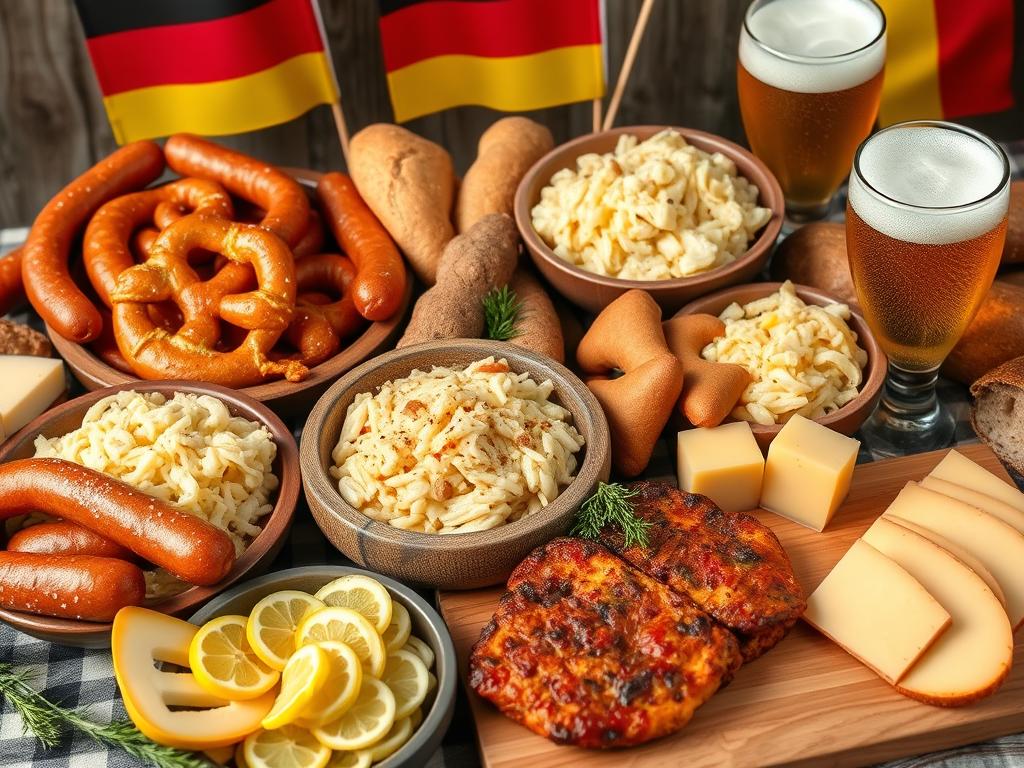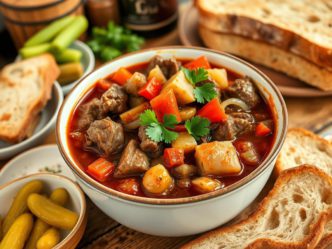Traditional German Foods
Have you ever wondered why German food is so loved worldwide? Discovering the top 10 traditional German foods reveals a world of flavors and history. These dishes are more than just food; they are a window into Germany’s vibrant culture and traditions.
From hearty meals to sweet treats, these classic recipes are a must-try. They offer a journey into the heart of German cuisine. Join us as we explore these dishes that capture the essence of traditional German food.
Key Takeaways
- Traditional German foods offer a unique blend of flavors and culture.
- The top 10 traditional German foods highlight the richness of German cuisine.
- Each dish tells a story steeped in history and regional significance.
- Classic German recipes are perfect for both everyday meals and special occasions.
- Exploring these dishes can deepen your appreciation for German culinary traditions.
Introduction to Traditional German Foods
Traditional German foods have a deep history and show the country’s rich culture and diversity. These dishes use many ingredients and cooking styles. They range from hearty meals to sweet treats, offering a unique culinary experience.
Social gatherings, family celebrations, and festivals like Oktoberfest show food’s key role in German culture. Sharing traditional German recipes at these times brings people together, creating a sense of belonging and nostalgia, connecting generations through food.
Discovering traditional German foods gives a glimpse into the daily lives of its people. It highlights the country’s agricultural richness. Each dish tells a story, often linked to history or local traditions. It brings the spirit of Germany to your plate.
The Rich History of German Cuisine
The story of German cuisine is truly captivating. It shows how different influences have shaped the nation over time. The history of German food began with simple dishes made from local ingredients.
Trade routes brought spices and new cooking methods to Germany. Wars and migrations also played a big role. They introduced different cultures and their cooking traditions.
German cuisine varies greatly from region to region. The south is known for hearty meat stews, while the north offers lighter fish dishes. Each area has its own special dishes, showing the deep history and local pride in German food.
s
Germany is known for its rich and varied food culture. Its dishes are famous for their hearty flavors and strong ingredients. These meals show off the country’s rich farming history and local specialties. We’ll examine the top German dishes, including their origins, main ingredients, and cooking methods.
A Brief Overview of Each Dish
- Sauerbraten: A pot roast made from beef, marinated in vinegar, water, and spices for days, then slow-cooked.
- Bratwurst: Delicious sausages made from pork, beef, or veal, seasoned with spices, found in many regions.
- Pretzels: Soft, twisted dough, often sprinkled with coarse salt, enjoyed as a snack throughout Germany.
- Schnitzel: Breaded and fried cutlets, usually from pork or veal, known for their crispiness and tenderness.
- German Potato Salad: Warm potatoes mixed with a tangy dressing, often including bacon and onions.
- Rinderroulade: Thin beef rolls filled with mustard, bacon, and pickles, simmered for a rich flavor.
- Black Forest Cake: A rich dessert with layers of chocolate sponge cake, cherries, and whipped cream.
- Spätzle: Soft egg noodles, a favorite side dish in many German regions.
- Sauerkraut: Fermented cabbage, adding a tangy flavor to many German dishes.
- Weihnachtsplätzchen: Traditional Christmas cookies enjoyed in various shapes and flavors during the holiday season.
Importance in German Culture
These classic German recipes are deeply meaningful to many families. They are often the center of social gatherings, celebrations, and festivals. Sharing these meals strengthens community bonds and connects generations. As people come together to enjoy these dishes, the spirit of togetherness and heritage is celebrated, showing the true heart of German cuisine.
Sauerbraten: The Pot Roast with a Twist
Sauerbraten is a beloved traditional German pot roast. It’s known for its unique marinating process. This makes the dish rich in flavor and tender.
Ingredients and Preparation
The main ingredient is beef, often chuck roast or round steak. These cuts are marinated in vinegar, water, and spices like bay leaves and cloves, tenderizing the meat and adding flavor.
- Beef (chuck or round cut)
- Vinegar (red wine or apple cider)
- Onions
- Carrots
- Spices (bay leaves, juniper berries, cloves)
- Beef broth
After marinating, the beef is seared on all sides. Then, it’s braised slowly to blend the flavors. The sauce, thickened with ginger snap cookies, adds sweetness and complexity.
Regional Variations
Different regions in Germany have their own Sauerbraten recipes. In the Rhineland, it’s sweeter, with raisins or apples. The Swabian region uses different spices and vinegar for a stronger flavor.
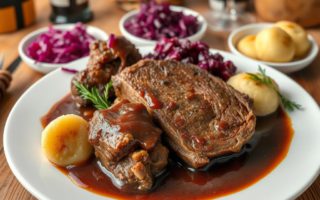
These variations show how Sauerbraten is loved across Germany. It’s a dish that locals cherish and adapts to their tastes.
Bratwurst: Sausages That Steal the Show
Bratwurst is a favorite among traditional German sausages. It comes in many flavors, from sweet to savory. Each region in Germany has its own special mix of spices and ingredients, making bratwurst a key part of German cuisine.
Types of Bratwurst
There are many types of bratwurst, each with its own story. Here are a few:
- Nürnberger Bratwurst: This small sausage comes from Nuremberg. It’s made with marjoram, pepper, and other spices.
- Thüringer Bratwurst: From Thuringia, this bratwurst is coarser. It’s loved grilled or fried.
- Regensburger Bratwurst: This one is from Regensburg. It’s known for its mild taste and is often served with sweet and sour mustard.
- Schwäbische Bratwurst: From Swabia, this bratwurst is a mix of veal and pork. It includes herbs like parsley and chives.
Bratwurst is a big hit at German festivals, especially at barbecues and Oktoberfest. It’s grilled to perfection and often served with sauerkraut or mustard. These sausages represent tradition and community spirit.
| Type of Bratwurst | Region | Main Ingredients | Serving Style |
|---|---|---|---|
| Nürnberger Bratwurst | Nuremberg | Pork, marjoram, spices | Grilled, served in a bun |
| Thüringer Bratwurst | Thuringia | Pork, garlic, spices | Grilled or fried |
| Regensburger Bratwurst | Regensburg | Pork, salt, spices | With mustard, served with bread |
| Schwäbische Bratwurst | Swabia | Veal, pork, herbs | Grilled or in dishes |
Pretzels: The Iconic German Snack
German pretzels are loved for their unique shape and chewy texture. They hold a special place in the hearts of snack lovers. This beloved staple is more than just a food item; it symbolizes traditional German snacks, often enjoyed at festivals and local gatherings.
The process of making pretzels is an art form. It requires attention to detail and a specific technique. This results in their captivating flavor and texture.
How Pretzels Are Made
The preparation of German pretzels starts with a simple mixture of flour, water, yeast, and salt. The dough is kneaded until it reaches the perfect consistency. This is essential for achieving that signature soft bite.
Once the dough rises, it is divided into pieces and rolled into the iconic twisted shape. A key step involves briefly boiling the pretzel in a baking soda solution before baking. This not only enhances color but also contributes to the distinctive chewy crust.
Popular Toppings and Dips
When enjoying German pretzels, the choice of toppings can elevate the experience. Common options include mustard, which pairs beautifully with the soft texture, and cheese sauce, adding a creamy richness. Other beloved accompaniments range from sweet options, like chocolate or cinnamon sugar, to savory herbs and spices.
These variations make pretzels a versatile choice among popular German dishes. They appeal to diverse palates.
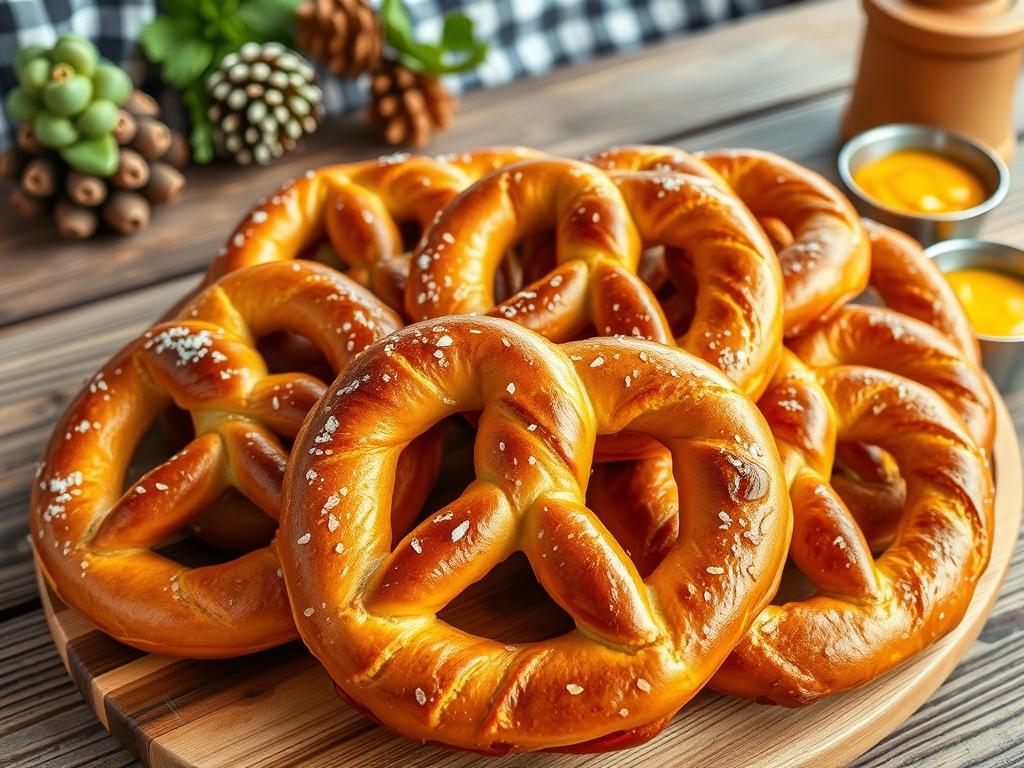
| Topping/Dip | Flavor Profile | Pairing Suggestions |
|---|---|---|
| Dijon Mustard | Spicy and tangy | Pairs well with beer |
| Cheese Sauce | Rich and creamy | Great for parties |
| Cinnamon Sugar | Sweet and aromatic | Perfect for dessert |
| Herbed Olive Oil | Fresh and flavorful | Excellent with salads |
Schnitzel: A Crispy Classic
Schnitzel is a favorite in traditional German foods, known for its crispy outside and tender meat. It comes from Austria but is loved in Germany too. There are many ways to make it, making it a top choice for both locals and tourists.
To make Schnitzel, meat like pork, veal, or chicken is thinly sliced. It’s then coated in flour, eggs, and breadcrumbs before frying, making the Schnitzel crispy and delicious.
In Germany, Schnitzel recipes vary by region. Wiener Schnitzel, from Austria, uses veal for a rich taste. Jägerschnitzel, on the other hand, has a mushroom sauce for a tasty twist. Each version offers a unique taste while keeping the Schnitzel’s essence.
- Wiener Schnitzel: Made with veal, is a classic representation of the dish.
- Jägerschnitzel: Includes a savory mushroom sauce, elevating the flavor profile.
- Rahmschnitzel: Features a creamy sauce for a decadent touch.
Trying Schnitzel lets you dive into the flavors of German cuisine. This crispy dish not only pleases the taste buds but also connects you to Germany’s rich food history. It’s a must-try for anyone looking to experience the best of German meals.
German Potato Salad: A Family Favorite
German potato salad is a favorite side dish at family gatherings and summer barbecues. It’s known for its unique flavors, showing the versatility of traditional German recipes. Different regions in Germany have their own versions, with local tastes and cooking styles.
Variations Across Regions
The traditional potato salad in southern Germany uses vinegar, onions, and bacon. This zesty and savory mix is served warm, making it perfect for spring and fall’s cooler weather.
In northern Germany, a creamy mayonnaise-based version is popular. It’s served chilled and often includes pickles and eggs, which add to its creamy texture.
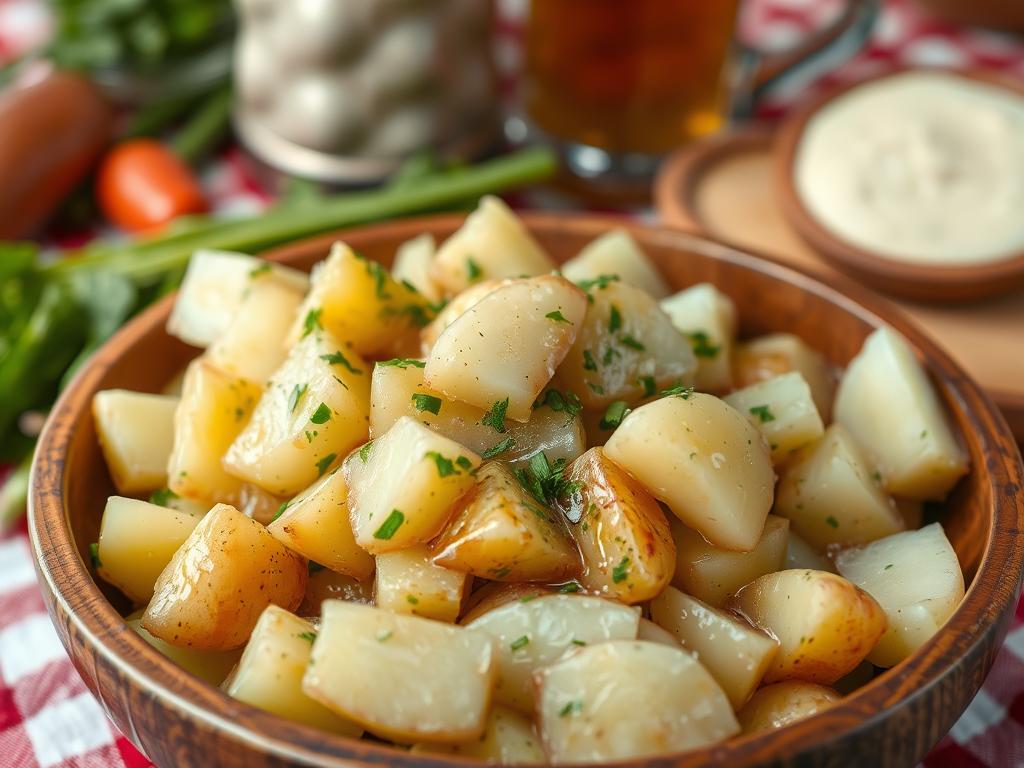
Both styles show how important potato salad is in German cuisine. They reflect regional identities and family traditions.
Rinderroulade: A Dish Fit for Celebrations
Rinderroulade is a standout dish in German cuisine, perfect for special occasions. It’s a rolled beef dish filled with bacon, onions, and pickles. This mix of flavors makes every bite a delight. Learning to make Rinderroulade opens up a world of classic German recipes great for family gatherings.
Cooking Tips and Tricks
Preparing Rinderroulade is easy, leading to a tender and tasty dish. Here are some tips to make your cooking better:
- Select High-Quality Beef: Choose a cut like flank or round steak for the best results.
- Mise en Place: Prepare and organize all ingredients before you start cooking.
- Marinate: Consider marinating the meat for a few hours to bolster flavor and tenderness.
- Roll Tightly: When rolling the beef, make sure to pack it tightly so the filling stays intact during cooking.
- Low and Slow: Cook Rinderroulade at a low temperature for an extended period to achieve a melt-in-your-mouth texture.
Black Forest Cake: A Sweet Delight
The Black Forest Cake is a famous German dessert. It’s known for its chocolate layers, creamy frosting, and tart cherries. It’s a favorite for birthdays and weddings.
This cake comes from Germany’s Black Forest region. It’s made with chocolate sponge cake, whipped cream, and cherries. Kirschwasser, a cherry schnapps, gives it a special flavor.
Desserts are key in many celebrations, and Black Forest Cake is no different. It’s a symbol of joy and indulgence. It’s a standout among traditional German foods.
| Component | Description |
|---|---|
| Chocolate Cake | Rich, moist layers made with cocoa powder. |
| Cherries | Fresh or preserved, adding a sweet-tart flavor. |
| Whipped Cream | Light and fluffy, used between layers and as a topping. |
| Kirschwasser | Cherry schnapps enhance the overall flavor. |
This cake is not only tasty but also connects us to German culture. Enjoy the Black Forest Cake and its rich history with every bite.
Spätzle: The German Noodle
Spätzle is like soft egg noodles and is very special in German cuisine. It’s a fun dish to make and enjoy. Its unique shape and texture make it stand out. Trying to make Spätzle yourself can be a fun and rewarding experience.
How to Make Homemade Spätzle
Making Spätzle is easy. You just need a few ingredients to make your meal better. Here’s a simple recipe to start with:
- 2 cups all-purpose flour
- 4 large eggs
- 1/2 cup milk or water
- 1/2 teaspoon salt
- Butter for sautéing
Here’s how to make delicious homemade Spätzle:
- In a mixing bowl, combine the flour and salt.
- Whisk together the eggs and milk or water in a separate bowl.
- Gradually add the egg mixture to the flour, stirring until a thick batter forms.
- Bring a large pot of salted water to a boil.
- Push the batter into the boiling water using a Spätzle maker or colander.
- Cook for 2-3 minutes or until the noodles rise to the surface.
- Remove with a slotted spoon and sauté in butter for added flavor.
Spätzle goes great with rich gravies or stews. It makes meals even better. Try adding cheese or herbs for extra taste. This shows how versatile and charming German dishes can be.
Sauerkraut: The Fermented Flavor Bomb
Sauerkraut is a traditional German dish made from finely shredded fermented cabbage. It has a tangy taste that comes from fermentation. This process uses natural lactic acid bacteria to turn fresh cabbage into a crunchy, flavorful treat full of probiotics.
Sauerkraut is packed with vitamins C and K. It helps with digestion and boosts the immune system. Adding it to meals can make them healthier and more satisfying.
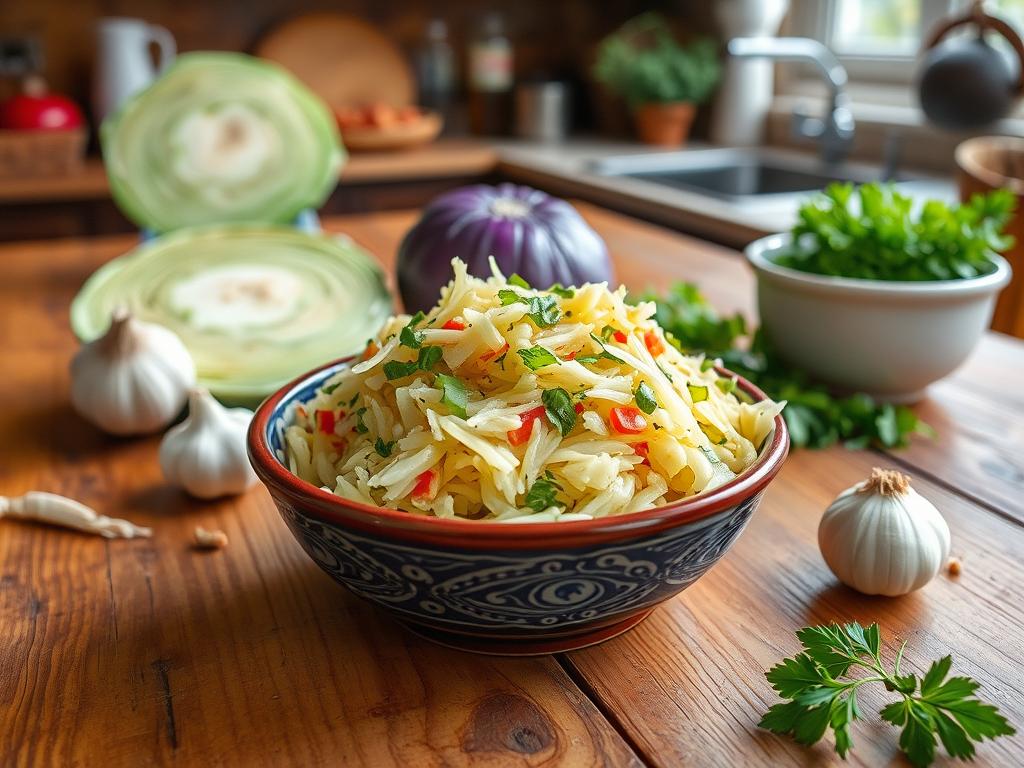
In German cuisine, sauerkraut goes well with meats and sausages. It makes meals more enjoyable. Try it with bratwurst or schnitzel for a true taste of Germany. Sauerkraut is deeply rooted in German culture, showing the value of preserving food.
| Aspect | Sauerkraut | Traditional Dishes |
|---|---|---|
| Type | Fermented Food | Meats, Sausages |
| Main Ingredient | Cabbage | Varies (pork, beef, etc.) |
| Health Benefits | Rich in Probiotics | Protein-rich |
| Serving Style | Side Dish | Entree |
Weihnachtsplätzchen: German Christmas Cookies
The holiday season in Germany is filled with joy and baking. Families come together to make Weihnachtsplätzchen or German Christmas cookies. These cookies come in many flavors, shapes, and decorations, adding to the holiday cheer.
Popular Recipes for the Holidays
There are many beloved recipes during the holidays. Some favorites include:
- Anisplätzchen: These aromatic anise-flavored cookies are loved by many.
- Zimtsterne: Cinnamon stars with a sweet almond glaze add a spicy flavor.
- Lebkuchen: Traditional gingerbread cookies, soft or spiced, are often given as gifts.
- Vanillekipferl: These delicate crescent-shaped cookies are dusted in powdered sugar and have a rich vanilla taste.
Every region in Germany has its own twist on these recipes, using local ingredients and customs. Baking Weihnachtsplätzchen is more than just making treats. It’s about sharing joy and celebrating together.
Where to Try Traditional German Foods in the U.S.
Exploring traditional German foods in the U.S. is a unique adventure. German restaurants across the country offer delicious, authentic dishes that take you straight to Germany with every bite. Here are some top German restaurants for the best traditional German meals.
Best German Restaurants
| Restaurant Name | Location | Signature Dish |
|---|---|---|
| Wurstküche | Los Angeles, CA | Bratwurst with Sauerkraut |
| Der Biergarten | Minneapolis, MN | Weisswurst with Sweet Mustard |
| Schmidt’s Sausage Haus | Columbus, OH | Sauerbraten |
| The Red Lion | New York, NY | Schnitzel Platter |
| Ein Prosit | Colorado Springs, CO | Homemade Spätzle |
These places show the diversity and flavors of German cuisine. Enjoying the best German meals in a cozy setting is unforgettable. Experience authentic German food in the U.S. and feel the heart of Germany.
Explore More German Recipes at Home
Exploring home cooking is a great way to enjoy traditional German foods. It’s fun for both newbies and experienced cooks, and they can all bring a bit of Germany into their kitchens.
Begin with some classic dishes. Sauerbraten and Schnitzel are great starters. They use special ingredients and cooking methods that highlight the essence of German cuisine.
- Look for authentic German ingredients at local markets and specialty stores.
- Use fresh, seasonal produce to make your dishes even better.
- Find detailed recipes online or in cookbooks to help you along the way.
Trying out these German dishes can boost your cooking skills and make for memorable meals. Thanks to the joy of home cooking, your kitchen can become a place where German culture thrives.
Why You Should Embrace German Cuisine
Exploring German cuisine means diving into a world of tasty flavors and filling meals. German dishes are known for their hearty ingredients, making them great for comfort food. They also use fresh, quality ingredients, which can help you eat healthier.
German food is all about sharing meals with others. Dishes like Bratwurst or Sauerbraten are perfect for family gatherings, helping create strong bonds and memorable moments.
Every dish in German cuisine has a story behind it. Each brings a unique taste, from the Black Forest Cake to the tasty Spätzle. By trying German food, you embark on a flavorful journey.
| Benefits of German Foods | Description |
|---|---|
| Rich Flavors | Bold and hearty taste that satisfies cravings. |
| Fresh Ingredients | Focus on locally sourced, high-quality food. |
| Cultural Connection | Encourages communal dining and sharing traditions. |
| Variety of Dishes | Diverse options for any palate, from savory to sweet. |
Adding German dishes to your meals brings not just great taste but also a deeper love for food culture. Join the fun and discover why German cuisine is so special.
Conclusion
Exploring traditional German foods reveals more than tasty dishes. It reveals a deep cultural identity that spans generations. Each dish, from Sauerbraten to Black Forest Cake, tells a story of German heritage.
These foods are not just meals; they connect us to Germany’s history. They carry stories of tradition and heritage. Every bite is a journey through time.
Enjoying traditional German foods is more than just eating. It’s about building community and family bonds. Whether cooking at home or dining out, German cuisine brings people together. It creates memories and shares joy.
So, grab a spatula or visit a German eatery. Dive into the world of German flavors. It’s a journey that will enrich your cooking and appreciation for German cuisine.
As you explore these dishes, you’ll see how they can enhance your cooking. They offer a wide range of flavors and experiences. Every meal is a chance to taste a piece of Germany and its rich culinary heritage.
You may also like :
German Recipes
Creamy Mississippi Chicken Enchiladas Recipe how to cook?
Texas-Style Slow-Cooker Brisket Recipe: Easy & Delicious
Barbecued Salmon in Wasabi and Soy Japanese Recipes
Discover the Traditional Japanese Chicken Teriyaki Recipe
Top 10 American Recipes: Classic Comfort Foods
Authentic Moroccan Tajine: Moroccan Cuisine
External link :
Wikipedia: Texas-style slow-cooker Brisket
FAQ
What are some popular traditional German foods?
Popular German foods include Sauerbraten, Bratwurst, and Pretzels. Schnitzel and Black Forest Cake are also favorites. These dishes highlight the variety and richness of German cuisine.
Are there any classic German recipes I can make at home?
Yes! Try making German Potato Salad, Rinderroulade, and Spätzle at home. These recipes use simple ingredients and techniques, showing the heartiness of German cooking.
Why is German cuisine important in cultural gatherings?
German cuisine is key in cultural gatherings. It represents tradition and community spirit. Dishes like Sauerbraten or homemade pretzels are central to family celebrations and festivals.
What makes Black Forest Cake unique?
Black Forest Cake is special. It has layers of chocolate cake, cherries, and whipped cream, often with Kirschwasser. This dessert is delicious and holds a special place in German celebrations.
How can I find traditional German foods in the U.S.?
Look for German restaurants in the U.S. Many places serve authentic German dishes like bratwurst and schnitzel. This way, you can enjoy Germany without leaving home.
What are some regional variations of German potato salad?
German potato salad varies by region. Southern Germany uses vinegar and bacon, while northern regions prefer creamy mayonnaise. This shows the diverse flavors of German cuisine.
Can you recommend any easy German recipes for beginners?
Yes! Beginners can try making Pretzels and Spätzle. These dishes need minimal ingredients and simple techniques, making them great for beginners.
What is the significance of pretzels in German culture?
Pretzels hold a special place in German culture. They’re often seen at festivals, gatherings, and Oktoberfest. Their unique shape and texture make them a favorite snack.
How is Sauerbraten traditionally prepared?
Sauerbraten is a classic German dish that is marinated in vinegar, water, and spices for days. This tenderizes the meat and enhances its flavors.
What types of bratwurst are there?
There are many types of bratwurst, each with its own flavor. Traditional Thuringian bratwurst is a favorite, often grilled. Nürnberger bratwurst is known for its small size and unique taste.
What role does sauerkraut play in German meals?
Sauerkraut is a tangy side dish in German meals. It’s made by fermentation and is prized for its flavor and health benefits. It’s often served with meats and sausages.
